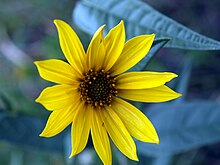Helianthus maximiliani
| Helianthus maximiliani | |
|---|---|

| |
| Wind Cave National Park, South Dakota | |
| Scientific classification | |
| Kingdom: | Plantae |
| Clade: | Tracheophytes |
| Clade: | Angiosperms |
| Clade: | Eudicots |
| Clade: | Asterids |
| Order: | Asterales |
| Family: | Asteraceae |
| Genus: | Helianthus |
| Species: | H. maximiliani |
| Binomial name | |
| Helianthus maximiliani | |
| Synonyms[1] | |
| |
Helianthus maximiliani is a North American species of sunflower known by the common name Maximilian sunflower.[2]
This sunflower is named for Prince Maximilian of Wied-Neuwied, who encountered it on his travels in North America.
Helianthus maximiliani is native to the Great Plains in central North America, and naturalized in the eastern and western parts of the continent. It is now found from British Columbia to Maine, south to the Carolinas, Chihuahua, and California. The plant thrives in a number of ecosystems, particularly across the plains in central Canada and the United States. It is also cultivated as an ornamental.[3][4]
Description
A branching perennial herb, growing from a stout rhizome and reaches heights from 0.5–3.0 m (1+1⁄2–10 ft). The rough, slender, tall, erect stems and alternately arranged leaves are covered in rough hairs.[2]
The lance-shaped leaves are narrow, rough, pointed, and folded down the midvein, and up to 30 cm (12 in) long on large plants.[2]
The flower heads are surrounded at the base by pointed green phyllaries which often stick straight out and curl at the tips. The center is filled with yellow tipped brown disc florets and the circumference is lined with bright yellow ray florets 2–4 cm (1–1+1⁄2 in) long.[2] The flowers give an odor similar to chocolate.
The plant reproduces by seed and by vegetative sprouting from the rhizome.[2]
Uses
The thick rhizome is edible and provided a food similar to the Jerusalem artichoke for Native American groups such as the Sioux. The flower heads are attractive to insects and the fruits are eaten by birds.[citation needed] Livestock eat portions of the plant, and the seeds are eaten by various wildlife.[5]
The Land Institute, a perennial agriculture research center located in Salina, Kansas, run by Wes Jackson is experimenting with this species to create a perennial oilseed grain crop that does not necessitate replanting each season.
References
- ^ "Helianthus maximiliani". The Global Compositae Checklist (GCC) – via The Plant List. Note that this website has been superseded by World Flora Online
- ^ a b c d e Schilling, Edward E. (2006). "Helianthus maximiliani". In Flora of North America Editorial Committee (ed.). Flora of North America North of Mexico (FNA). Vol. 21. New York and Oxford: Oxford University Press – via eFloras.org, Missouri Botanical Garden, St. Louis, MO & Harvard University Herbaria, Cambridge, MA.
- ^ Anthony W. Kahtz (17 April 2008). Perennials for Midwestern Gardens: Proven Plants for the Heartland. Timber Press. pp. 55–. ISBN 978-0-88192-893-8. Retrieved 29 November 2010.
- ^ "Helianthus maximiliani". County-level distribution map from the North American Plant Atlas (NAPA). Biota of North America Program (BONAP). 2014.
- ^ Niering, William A.; Olmstead, Nancy C. (1985) [1979]. The Audubon Society Field Guide to North American Wildflowers, Eastern Region. Knopf. p. 385. ISBN 0-394-50432-1.
External links
- Jepson Manual Treatment
- United States Department of Agriculture Plants Profile
- United States Department of Agriculture, National Forest Service Ecology
- United States Geologic Survey, Northern Prairie Wildflowers
- Lady Bird Johnson Wildflower Center, University of Texas, Photo gallery
- Land Institute
- Photo of herbarium specimen at Missouri Botanical Garden, collected in Missouri in 1951, neotype for Helianthus maximiliani neotype designated in Heiser, C. B. 1966. The North American sunflowers (Helianthus). Mem. Torrey Bot. Club 22(3): 154(157).


